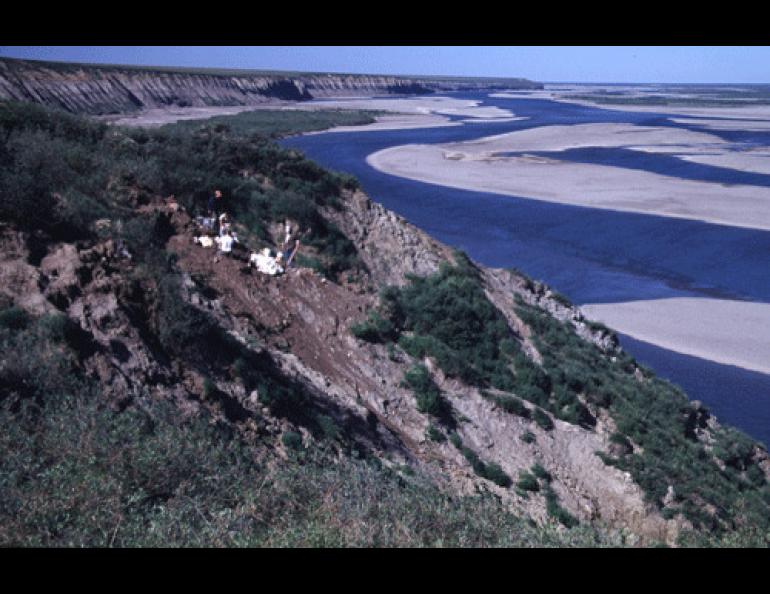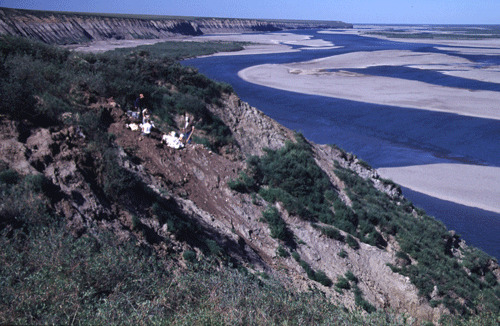
The killing field of northern Alaska
On a fine spring day about 70 million years ago, a few dozen duck-billed dinosaurs waded a channel of a great northern river. As they strode on two legs into the cloudy water, the man-size hadrosaurs had no idea how the sunshine was affecting the snowpack in the high mountains to the south.
A pulse of meltwater from the high country had swollen the river to much higher levels in the span of just a few hours. The dinosaurs ventured out too far, lost their footing, struggled and drowned. The river carried the bodies of the beasts downstream, depositing them at what is now a bend of the Colville River.
In a new paper, researchers write that large floods in ancient Alaska may be responsible for the impressive deposits of dinosaur bones they have found on Alaska’s North Slope.
“The Cretaceous Arctic of northern Alaska may have witnessed the coastal plain being a seasonal killing field,” wrote Tony Fiorillo, Paul McCarthy and Peter Flaig in an upcoming issue of the journal Palaeogeography, Palaeoclimatology, Palaeoecology.
Fiorillo, a frequent visitor to Alaska, works at the Museum of Nature & Science in Dallas. McCarthy is with the University of Alaska Fairbanks Department of Geology and Geophysics and the Geophysical Institute. Flaig studies at the Bureau of Economic Geology in Austin, Texas.
The researchers have spent many hours excavating bones and looking at soils and sediments on the Colville River and other places in Alaska. The dense concentration of the bones of young dinosaurs and fine river sediments at the Colville sites makes them think that sudden flooding events, possibly enhanced by non-permeable permafrost soils high in the ancient Brooks Range, may have led to the extraordinary beds of bones they have found.
Fiorillo, in Fairbanks for a workshop, said the prehistoric river delta on Alaska’s North Slope was probably a dangerous place to be during high runoff times, such as spring snowmelt or summer thunderstorms.
“Given the unique geography of high mountains next to a warm coastal plain in a polar world, there was a greater probability of getting clocked by a flood than places farther south,” Fiorillo said.
Alaska in the time of the dinosaurs was much warmer than it is today. Researchers have found ancient pollen of ferns and other plants that suggest the North Slope was more like a Louisiana bayou than the frigid place it is today, though the uplands of the emerging Brooks Range might have been cold enough to develop permafrost (ground that remains frozen through the heat of two consecutive summers).
Finding such a large concentration and variety of dinosaur bones, including those of four meat-eaters and four plant-eaters, made the researchers think that some catastrophic event probably killed them and buried them quickly. A surplus of young dinosaur bones seems to reinforce the notion of an extreme runoff event — taller, more able adult dinosaurs might have reached the other side of flood channels.
“It’s not a horrific flood,” Fiorillo said. “Basically, rising water where you run out of land is the appropriate model.”
“It might have been akin to Bangladesh,” said McCarthy. “There’s lots of water everywhere and lots of channels.
“The sediment is very muddy,” McCarthy said. “The rivers were at least as chocolate-milky as the Tanana.”
That sediment helped preserve the dinosaur bones, few of which show the teeth marks of predators or scavengers that might have piled them together. The scientists think today’s dinosaur hunters may have also gotten lucky in that the seasonal floods may have killed groups of dinosaurs when they were at peaks in their populations, similar to the booms of snowshoe hares and lemmings.
“The Cretaceous of northern Alaska may have been a tough place to grow up if one happened to be a dinosaur,” Fiorillo said.





